Mezzanine Financing 101: Definition, How it Works (2025 Updated)


In architecture, a mezzanine floor is an intermediate level that bridges the gap between two separate floors. That same sense holds for mezzanine financing, which enables companies to reach levels of capital raising that might not otherwise have seemed possible.
DealRoom regularly helps its clients prepare for an efficient process of raising capital, allowing us to look at mezzanine financing in detail and take you through everything from how it works to when you should look for it.
What is Mezzanine Financing?
Mezzanine financing is a hybrid form of financing, which combines features of debt and equity. Because of its hybrid form, mezzanine financing is sometimes considered a middle ground between debt and equity, enabling the company to benefit from both, and in doing so, raise higher levels of capital.
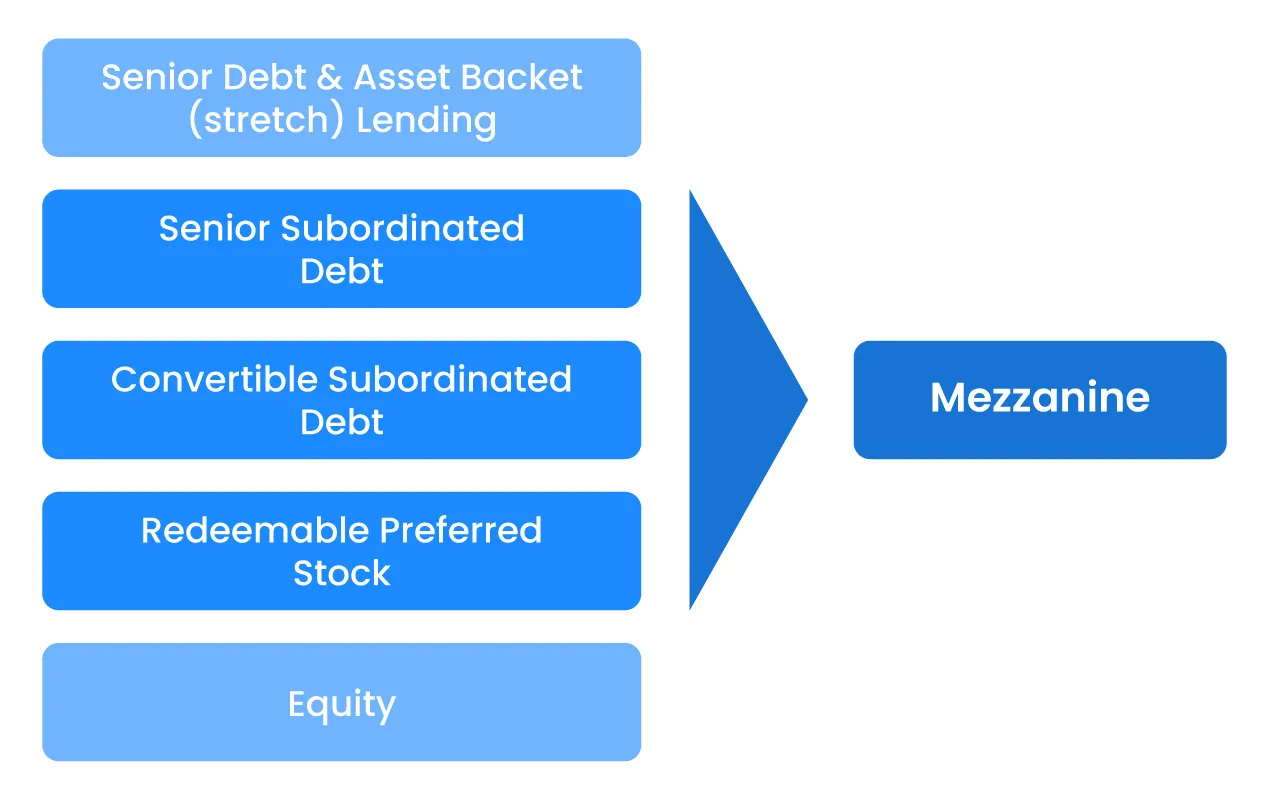
One of the principal drawbacks of mezzanine financing - discussed in more detail below - is that it involves a higher level of risk than traditional debt financing.
wHow Does Mezzanine Financing Work?
Mezzanine financing is a creative means of raising capital for companies which have maximized their capacity for senior debt, a point usually considered to be at around 80% of a company’s capital structure, but still want to pursue growth opportunities that require large amounts of capital such as acquisitions.
In these scenarios, mezzanine debt is often preferred to equity financing.
As you might have guessed, the hybrid nature of mezzanine financing means it contains elements of the risk and return inherent in both debt and equity financing. It is higher risk than debt financing, but also promises higher returns.
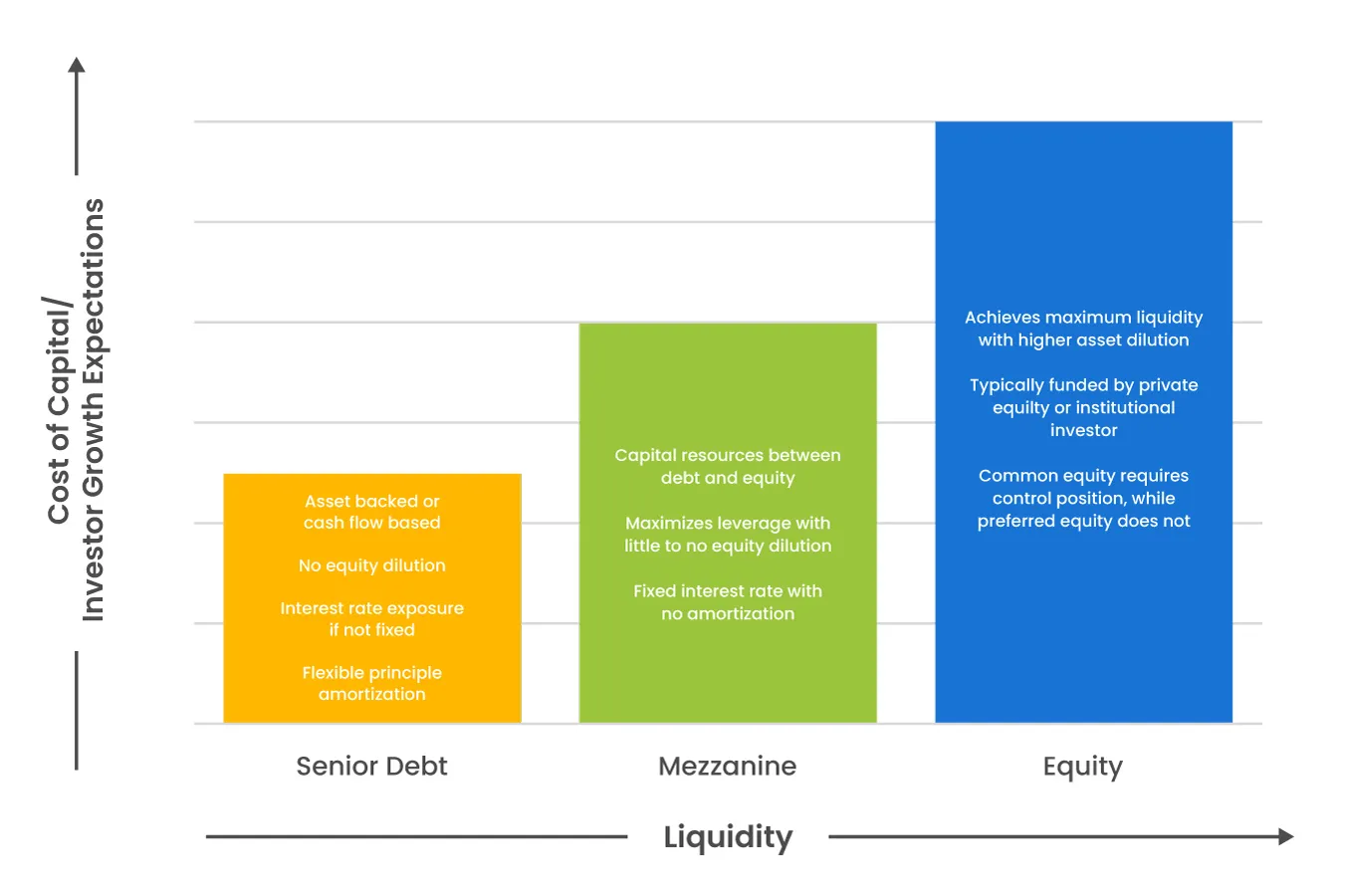
On the other hand, it is lower risk than equity financing, but similarly promises lower returns. In terms of priority of repayment, mezzanine financing ranks behind senior debt (which it why it sometimes termed ‘subordinated debt’) but before equity capital (i.e. repaying stockholders).

Usually but but not always, the mezzanine financing has warrants embedded, which state that if the company cannot repay its debt, the lender can convert the outstanding debt into an equity stake in the company - sometimes referred to as the ‘equity kicker’.
As mentioned at the outset, the equity component of mezzanine financing gives it a higher risk profile than senior debt, with mezzanine financing annual interest typically coming in at close to 20%.
This higher risk component means that mezzanine debt rarely constitutes more than 15-20% of a company’s capital structure.
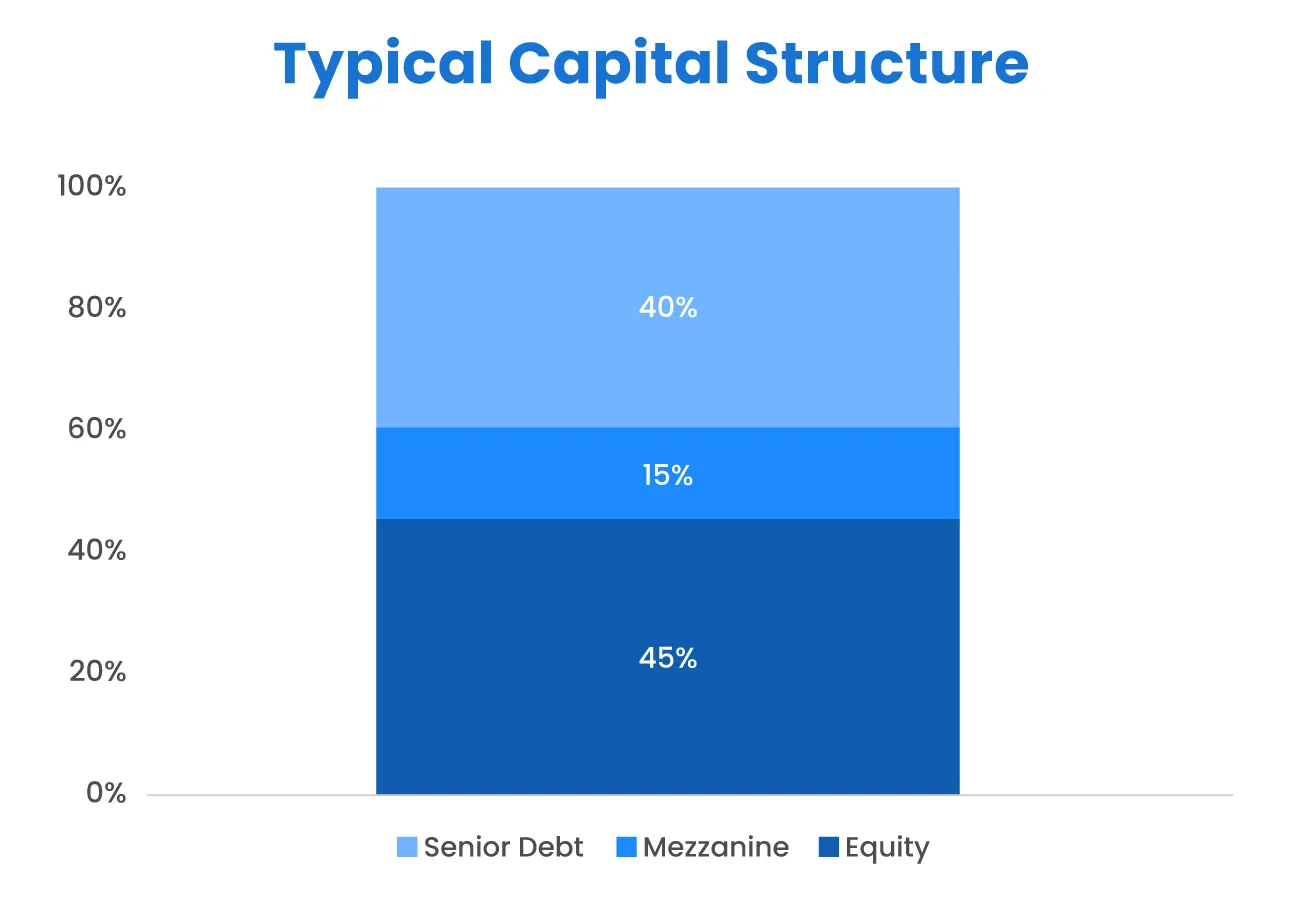
Mezzanine financing provides companies with a more aggressive means of achieving growth than senior debt allows. Mezzanine financing is usually unsecured, with a longer dated maturity than traditional senior debt, and is interest only.
This combination of characteristics makes it an attractive form of financing for companies which are making relatively low risk investments in large capital projects (for example, a highly undervalued acquisition that promises to generate huge value).
Why Is It Called Mezzanine Financing?
The origin of the word Mezzanine is the original Italian word for medium, mezzanino - itself coming from the latin word, mediano (which gave us the economic term, median).
The sense for mezzanine financing is that it’s a middle ground between debt and equity. A point some way between the two forms of traditional financing. Mezzanine financing is thought to be a relatively new form of financing, with origins in the 1980s.
Types of Mezzanine Financing
In the opening description of mezzanine financing, we noted that it is a ‘creative’ form of capital raising. This creativity is reflected in the different forms that mezzanine financing takes. These forms include, but are not limited to:
.webp)
Mezzanine Financing Structures
When mezzanine finance combines with senior debt and equity capital, it can optimize a company’s capital structure, minimize its cost of capital, and generate significant growth. The structures employed by mezzanine finance borrowers depend primarily on the objective of the transaction, the existing capital structure in place, and expected cash flows (in-flows from the project, and out-flows from the interest payments).
On the other side of the equation, the mezzanine lenders look at the benefits they’ll receive from providing the funds, look for a target rate of return that can be earned through a combination of current and deferred payments.
With some negotiation, the two sides arrive at a structure that works for both. These structures typically look like some of the following:
- Unsecured (high yield) debt: Mentioned in the box in the previous section, this is junior debt which is not secured by any collateral.
- Debt securities: The decision on whether to opt for unsecured debt or debt securities will usually be dictated by the investor’s view on market liquidity.
- Preferred stock: Less common than unsecured debt, this can take a range of different forms and is preferable to common stock only in its priority for repayment.
- Co-investment rights: Whereby the mezzanine financing is made by an investor with the intention of also acquiring in equity of the company.
- PIK (payment in kind) interest: A form of payment in which the interest payment is capitalized and added to the principal.
- Bonus Payment: Usually this is made when the value of the company has risen by a material amount over the time of the mezzanine financing.
Uses for Mezzanine Financing
A key advantage over other instruments is that mezzanine financing allows many variations of the transaction structure. This allows to use mezzanine in virtually all types of transactions.
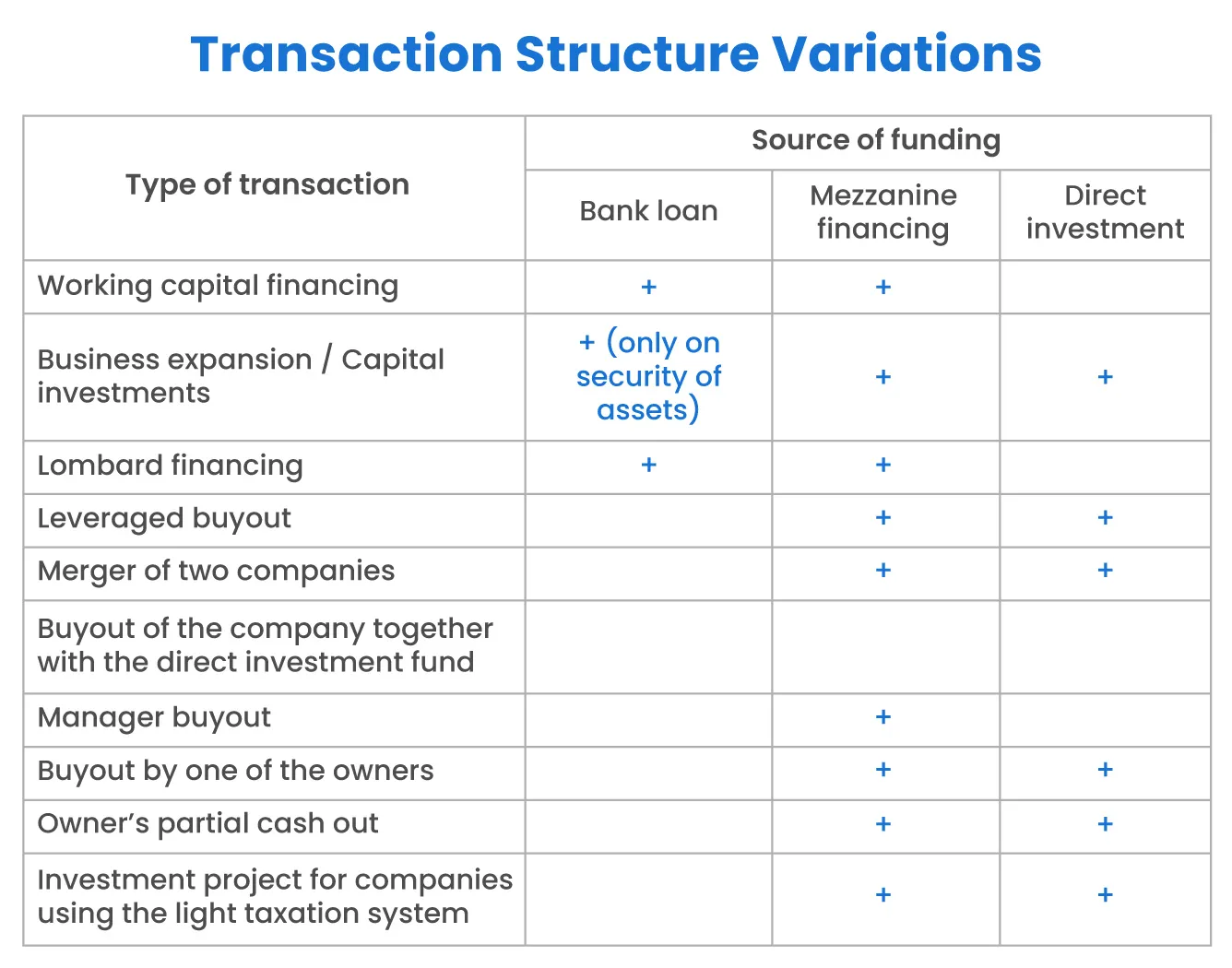
The numerous structures of mezzanine financing make it a versatile financing option for several corporate finance operations. Perhaps the one caveat is that the higher risk inherent in borrowing mezzanine financing means that returns have to be commensurate.

The list of transactions that companies can use mezzanine financing for, includes:
Mergers and Acquisitions
Mezzanine financing provides a viable solution to companies that want to acquire a target business, but require a large amount of debt to do so (a common occurrence in the case where the target company’s stockholders have no interest in obtaining the buyer’s stock). In this case, the buyer would turn to a mezzanine finance provider who could provide mezzanine debt, facilitating the transaction.
Recapitalizations
Recapitalizations involve changing the capital structure of a company - shifting the debt to equity balance. In certain scenarios, stockholders may want liquidity but not a full sale of their business. In these cases, private equity firms may opt to give them a mezzanine financing solution that provides an optimal combination of liquidity and retained ownership.
Refinancings
A refinancing could be used by a company for extra liquidity required for various business operations (working capital, for example) or simply to pay off existing debt with higher interest.
Leveraged Buyouts (LBOs)
Following the same logic as using mezzanine financing for an acquisition, LBOs frequently use mezzanine financing to maximize their leverage before making the acquisition attempt. This is equally true of Management Buyouts (MBOs), where the goal is to maximize borrowing capacity, and mezzanine financing can facilitate that.
Stockholder Buyouts
In certain situations, a majority shareholder will seek to obtain further (or full) control over the company stock by buying out other stockholders. The buyer may choose mezzanine financing as a means of achieving this, bringing enough liquidity to the business to buy out the other shareholder’s interests in the company.
How does Mezzanine Financing Compare to Other Types of Capital
When considering how mezzanine financing compares to other types of capital, it’s useful to consider a few different factors, specifically cost of capital (which is directly related to investors’ growth expectations), and liquidity.
The following chart provides an easy-to-understand overview of the differences between each form of capital:
- Asset-based loans: Asset-based loans are term loans that use assets on a company’s balance sheet as security (or collateral) against lending.
- Senior secured debt: Senior secured debt is effectively an asset-based loan which will be paid before all other loans (i.e., it is senior to them).
- Senior unsecured debt: Senior unsecured debt is unsecured debt (i.e., there is no collateral) which is senior to all other unsecured debt.
- Subordinated mezzanine debt: The focus of this article.
- Preferred equity: Preferred equity is equity with features that common equity doesn’t have such as a higher claim on assets and extra voting rights, for example.
- Common equity: Common equity (or “stock”) is the amount that all investors have invested in a company, with each stock giving the investor part ownership of the company and its cash flows.
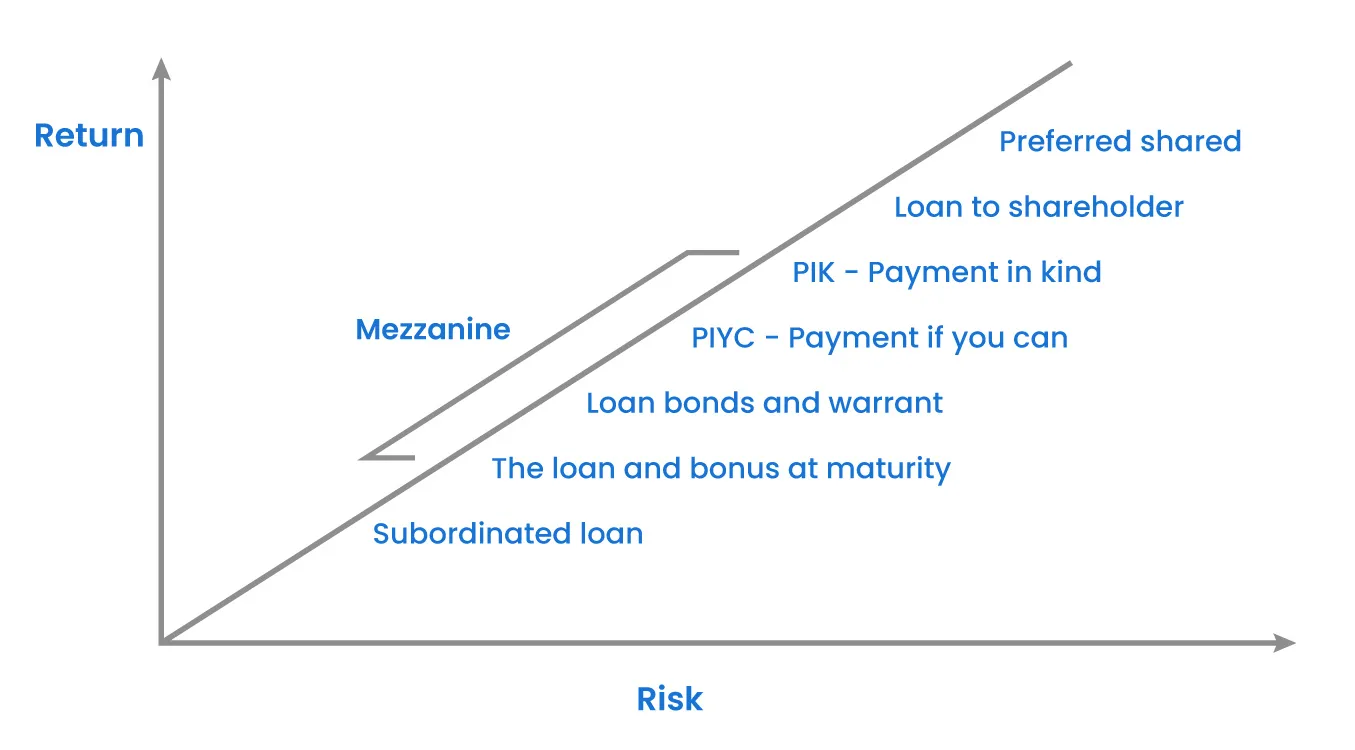
Who Should Seek Mezzanine Financing?
Any company or investor seeking liquidity for a well-defined strategic purpose may do well to consider mezzanine financing. The high interest payments mean that there has to be a solid motive (and business plan) behind the bid to obtain the financing. Without it, a company which already lacks liquidity may find itself in an even worse position.
Those seeking mezzanine financing typically fall into one of a few categories:
- Low liquidity: The most common reason for obtaining mezzanine financing is to obtain liquidity. It follows that the most common group seeking this type of capital lacks liquidity.
- Growth ambitions: Mergers and acquisitions, capital development, and other corporate development functions can all be facilitated by mezzanine financing.
- Ownership ambitions: MBOs and shareholder buyouts (both effectively combination oft he previous two categories) are usually facilitated by at least some mezzanine financing.
Advantages and Disadvantages of Mezzanine Financing
Advantages
- From an investor’s point of view, mezzanine financing can often lead to co-investing opportunities with high growth companies.
- The higher interest charged in mezzaine financing also leads to better rates of return on investment for successful investments.
- From the borrower’s standpoint, mezzanine financing offers a means to acquire liquidity when the senior debt borrowing capacity has surpassed, or is near to exhaustion.
- The interest payments on mezzanine financing are tax deductible, making it an attractive option for borrowers looking to reduce their tax burden while stimulating growth.
- If the borrower’s business plan delivers on its promise, the interest can be paid down faster, enabling them to restructure the terms on their loans at lower interest rates.
Disadvantages
- For both the lender and borrower, the higher interest rates in mezzanine financing, by their nature, create a higher default risk.
- Despite the relatively easy access to liquidity that mezzanine financing provides borrowers, built in covenants mean that it can be restrictive and may lead to share dilution
- In the event that the company cannot repay its lenders, it is doubtful how valuable the equity they acquire will be worth to them.
- The sometimes complex nature of mezzanine financing means that it’s not always easy to find a willing lender, and when one is found, it can take time to negotiate the terms.
Mezzanine Financing Example
Sensing its opportunity to capitalize on diminished credit access for lower-rated transactions, Goldman Sachs in September announced that it was raising a $15 billion mezzanine finance fund, which it would use to gain access to attractive private credit opportunities brought about by the combination of rising interest rates, inflation, and oil prices.
The thinking is that these companies, unable to access the credit lines that had fueled their growth until now, will now turn to Goldman Sachs to access mezzanine finance at a higher rate of interest, thereby pushing up Goldman Sachs’ own return on investment.
Mezzanine Financing Lenders
A frequently asked question is: Do banks provide mezzanine financing?
Yes and no. Usually, banks - specifically investment banks - only provide mezzanine financing to large corporate clients with annual revenues running into the hundreds of millions.
At the lower end, in the middle and lower middle markets, mezzanine financing can be provided by special private debt providers, private equity companies, or even funds looking to diversify their cash flows.
The Mezzanine Financing Process
What should you expect when you’re raising mezzanine financing?
Any company looking to raise mezzanine financing should expect something similar to the standard debt raising process, with the caveats that mezzanine financing tend to take longer, and anecdotally at least, there are far less participants willing to offer it as an alternative.
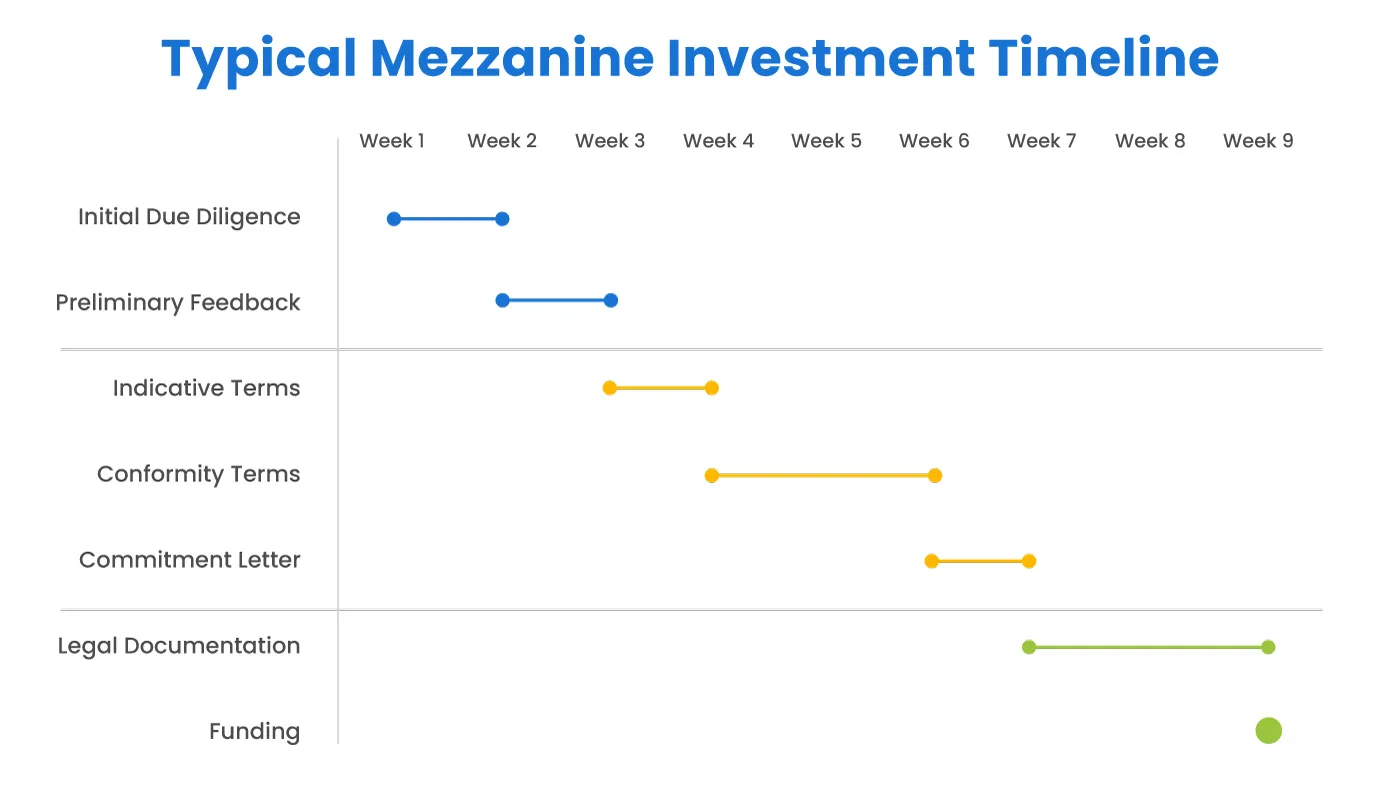
That being said, the mezzanine financing process will include the following steps:
1. Development of a business plan
Whoever is providing the plan will want to see evidence that the debt will be repaid. Whatever the purpose of the debt - an M&A transaction, a recapitalization, etc. - it’s better to be armed with a business acquisition plan.
2. Selection of a partner
As with all capital raising transactions, the attractiveness of your business will determine to a great extent which partners are open to working with you. If you’re business isn’t particularly attractive, the selection process may be a short one.
3. Negotiation of terms
As mentioned, the terms can be stringent. In the current market (where Goldman Sachs has entered), we can be sure that the terms are beginning to favor lenders at the expense of borrowers. To learn more about term sheet negotiation, check out How Atlassian Negotiates a Term Sheet
4. Documentation
This can be one of the most challenging and time consuming parts of mezzanine financing. The list of documents demands extensive due diligence on behalf of the borrower and by extension, a good data room tool.
Documents may include:
- Share purchase agreements: These share purchase agreements are usually replete with covenants and terms that kick in under certain conditions.
- Inter-creditor agreements: Whereby the mezzanine finance receives the backing of the senior creditors that have already extended credit to the firm.
- A co-investment option or warrant agreement: Wherein the equity participation of the investor is outlined.
- Other documents: These are likely to include registration rights, outlining agreements with existing stockholders in the borrower company.
Who are the Potential Partners?
The complexity of mezzanine financing means the right partnerships can add significant value to the process. In particular, these include:
- Legal partners: The fine print details in mezzanine finance contracts are far larger than in standard capital raising contracts. It can pay to bring in legal assistance to work with your in-house legal team to navigate this legal complexity.
- Industry specialists: If your company is seeking out mezzanine financing for the first time, bringing in an intermediary with experience in the field - at least for a short period - can help when developing the pitch and deciding among mezzanine finance providers.
- Technology: There is no way around using technology in the mezzanine finance process. It is too long, too detailed, too document-laden a process to avoid. Use all technology that can help the process, from project management tools to intelligent data rooms.
How to Select a Mezzanine Finance Lender
There are estimated to be over 1,000 mezzanine finance lenders in the United States, so there is scope for a wide range of different terms for a company’s mezzanine finance requirements.
In reality, once industry specializations and company size restrictions are removed, there may be be only a relatively small fraction of these mezzanine finance providers which are still relevant. Suppose the number of applicable providers is 200. Assuming there’s good demand to provide a company with mezzanine finance, how should its executives decide on a suitable lender?
- Track record: The difficulty inherent in deal implementation means that rack record is everything in mezzanine finance. Look for companies with dozens of deals in their portfolio rather than those with a handful.
- Terms: A company which has the luxury of choosing between several lenders is more likely to be able to dictate terms in their favour. Companies seeking funds should shop around for the terms that closest resemble their ideal requirements.
- Partnership potential: Under certain circumstances, as the mezzanine finance contract dictates, the lender could become an equity holder in the company. For this reason, the borrower has to decide if, in such a scenario, they would want a lender to be involved in their company.
DealRoom’s Takeaways
Mezzanine finance is a creative alternative for companies which already have significant levels of senior debt on their balance sheet to raise capital.
It also tends to be a far more complex method of raising capital than more regular methods. Prepare well, bring in partners, and use technology to reduce the complexity and diminish the learning curve.
Talk to DealRoom today about how our project management tool for capital raising can assist your company in this endeavour.
Get your M&A process in order. Use DealRoom as a single source of truth and align your team.





.png)
.png)
.png)
.svg)

.svg)
.png)


